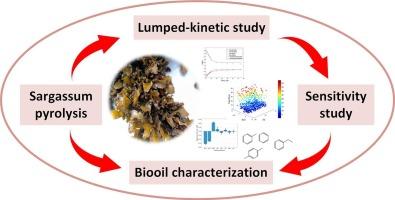马尾藻热解过程中生物油表征的动力学建模和拉丁超立方采样敏感性分析
Q1 Environmental Science
引用次数: 0
摘要
本研究采用Di Blasi(1996)(模型1)和Farag et al.(2014)(模型2)这两种具有竞争性的集总动力学模型,对不同粒径的马尾藻的热解动力学进行了研究。敏感性分析采用拉丁超立方抽样(LHS)和Spearman秩相关进行评估。结果表明,模型1提供了较好的拟合,反映在较高的R2和较低的RMSE值上。敏感性分析显示,模型1中影响最大的参数是Ea3(10-40目)和Ea1(40-70目和70-100目),而模型2中影响最大的参数是Ea4(10-40目)和Ea3(40-70目和70-100目)。在±30%的参数变化下,总误差值主要保持在10以下。轻相生物油(29.72 MJ/kg)以醇类为主,重相生物油(2.95 MJ/kg)以羧酸类为主。这些发现突出了马尾藻衍生的光相生物油作为化石燃料替代品的巨大潜力。本文章由计算机程序翻译,如有差异,请以英文原文为准。

Integrated kinetic modeling and Latin hypercube sampling-based sensitivity analysis with bio-oil characterization in the pyrolysis of Sargassum sp
This study investigates Sargassum sp. pyrolysis kinetics using two competitive lumped kinetic models: Di Blasi (1996) (Model 1) and Farag et al. (2014) (Model 2), across varying particle sizes. Sensitivity analysis was assessed using Latin Hypercube Sampling (LHS) and Spearman rank correlation. The results indicate that Model 1 provided a superior fit as reflected by higher R2 and lower RMSE values. Sensitivity analysis revealed that the most influential parameters in Model 1 were Ea3 (for 10–40 mesh) and Ea1 (for 40–70 and 70–100 mesh), whereas in Model 2, Ea4 (for 10–40 mesh) and Ea3 (for 40–70 and 70–100 mesh) were most significant. Under ±30 % parameter variation, total error values predominantly remained below 10. A light-phase bio-oil (29.72 MJ/kg) was rich in alcohols, while a heavy-phase bio-oil (2.95 MJ/kg) dominated by carboxylic acids. These findings highlight the strong potential of Sargassum-derived light-phase bio-oil as an alternative to fossil fuels.
求助全文
通过发布文献求助,成功后即可免费获取论文全文。
去求助
来源期刊

Bioresource Technology Reports
Environmental Science-Environmental Engineering
CiteScore
7.20
自引率
0.00%
发文量
390
审稿时长
28 days
 求助内容:
求助内容: 应助结果提醒方式:
应助结果提醒方式:


